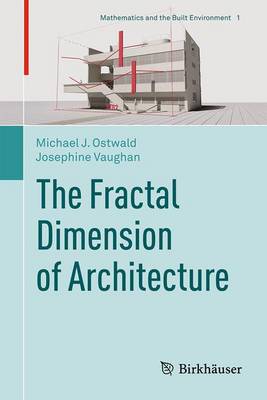Mathematics and the Built Environment
2 primary works
Book 1
The Fractal Dimension of Architecture
by Michael J. Ostwald and Josephine Vaughan
Fractal analysis is a method for measuring, analysing and comparing the formal or geometric properties of complex objects. In this book it is used to investigate eighty-five buildings that have been designed by some of the twentieth-century's most respected and celebrated architects. Including designs by Le Corbusier, Eileen Gray, Frank Lloyd Wright, Robert Venturi, Frank Gehry, Peter Eisenman, Richard Meier and Kazuyo Sejima amongst others, this book uses mathematics to analyse arguments and theories about some of the world's most famous designs.
Starting with 625 reconstructed architectural plans and elevations, and including more than 200 specially prepared views of famous buildings, this book presents the results of the largest mathematical study ever undertaken into architectural design and the largest single application of fractal analysis presented in any field. The data derived from this study is used to test three overarching hypotheses about social, stylistic and personal trends in design, along with five celebrated arguments about twentieth-century architecture. Through this process the book offers a unique mathematical insight into the history and theory of design.
Book 3
The Mathematics of the Modernist Villa
by Michael J. Ostwald and Michael J. Dawes
This book presents the first detailed mathematical analysis of the social, cognitive and experiential properties of Modernist domestic architecture.
The Modern Movement in architecture, which came to prominence during the first half of the twentieth century, may have been famous for its functional forms and machine-made aesthetic, but it also sought to challenge the way people inhabit, understand and experience space. Ludwig Mies van der Rohe's buildings were not only minimalist and transparent, they were designed to subvert traditional social hierarchies. Frank Lloyd Wright's organic Modernism not only attempted to negotiate a more responsive relationship between nature and architecture, but also shape the way people experience space. Richard Neutra's Californian Modernism is traditionally celebrated for its sleek, geometric forms, but his intention was to use design to support a heightened understanding of context. Glenn Murcutt's pristine pavilions, seemingly the epitome of regional Modernism, actually raise important questions about the socio-spatial structure of architecture.
Rather than focussing on form or style in Modernism, this book examines the spatial, social and experiential properties of thirty-seven designs by Wright, Mies, Neutra and Murcutt. The computational and mathematical methods used for this purpose are drawn from space syntax, isovist geometry and graph theory. The specific issues that are examined include: the sensory and emotional appeal of space and form; shifting social and spatial structures in architectural planning; wayfinding and visual understanding; and the relationship between form and program.

